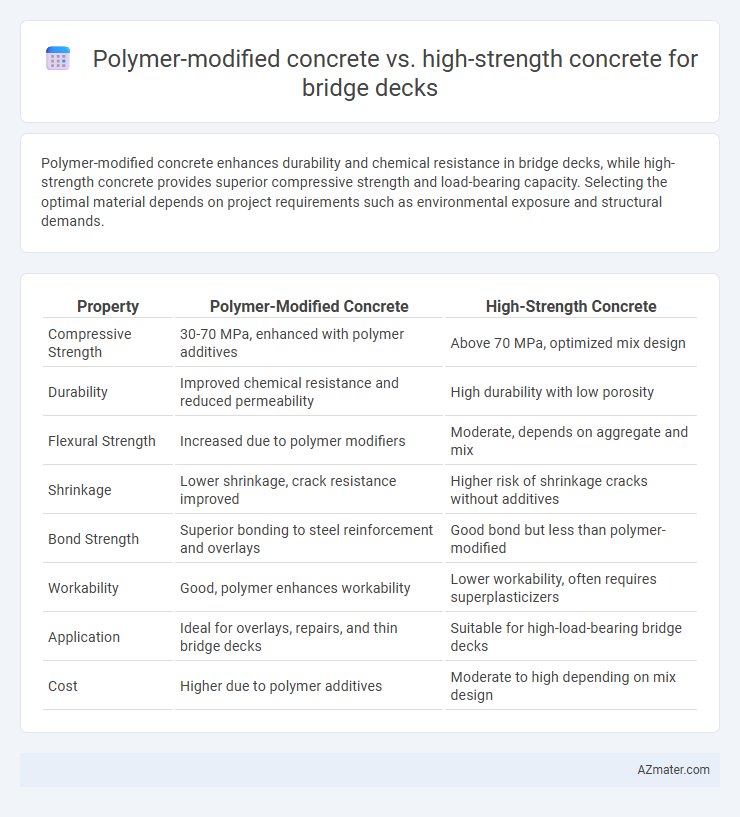Polymer-modified concrete enhances durability and chemical resistance in bridge decks, while high-strength concrete provides superior compressive strength and load-bearing capacity. Selecting the optimal material depends on project requirements such as environmental exposure and structural demands.
Table of Comparison
| Property | Polymer-Modified Concrete | High-Strength Concrete |
|---|---|---|
| Compressive Strength | 30-70 MPa, enhanced with polymer additives | Above 70 MPa, optimized mix design |
| Durability | Improved chemical resistance and reduced permeability | High durability with low porosity |
| Flexural Strength | Increased due to polymer modifiers | Moderate, depends on aggregate and mix |
| Shrinkage | Lower shrinkage, crack resistance improved | Higher risk of shrinkage cracks without additives |
| Bond Strength | Superior bonding to steel reinforcement and overlays | Good bond but less than polymer-modified |
| Workability | Good, polymer enhances workability | Lower workability, often requires superplasticizers |
| Application | Ideal for overlays, repairs, and thin bridge decks | Suitable for high-load-bearing bridge decks |
| Cost | Higher due to polymer additives | Moderate to high depending on mix design |
Introduction to Modern Bridge Deck Materials
Polymer-modified concrete enhances durability and chemical resistance in bridge decks by incorporating polymers that improve adhesion and reduce permeability, making it ideal for harsh environmental conditions. High-strength concrete offers superior compressive strength and load-bearing capacity, enabling slimmer deck designs and longer spans in modern bridge construction. Both materials advance bridge deck performance, with polymer modification focusing on longevity and high-strength concrete optimizing structural efficiency.
Key Properties of Polymer-Modified Concrete
Polymer-modified concrete (PMC) for bridge decks exhibits enhanced adhesion, reduced permeability, and superior resistance to chemical attacks, which significantly prolongs the lifespan of the structure. The incorporation of polymers improves tensile and flexural strength, addressing common issues like cracking and freeze-thaw damage typical in high-strength concrete (HSC). PMC's elasticity and durability make it a preferred choice over HSC for applications requiring superior resistance to environmental and mechanical stresses.
Defining High-Strength Concrete for Bridge Applications
High-strength concrete (HSC) for bridge decks is characterized by a compressive strength typically exceeding 6000 psi (approximately 41 MPa), optimized to enhance load-bearing capacity and durability under heavy traffic loads and environmental stressors. It exhibits reduced permeability and improved microstructure, resulting in superior resistance to freeze-thaw cycles, chemical attacks, and abrasion compared to conventional concrete. Polymer-modified concrete, by contrast, incorporates polymers to enhance adhesion and flexibility but usually does not reach the same compressive strength levels critical for high-stress bridge deck applications.
Durability and Longevity: Comparative Analysis
Polymer-modified concrete enhances bridge deck durability by improving resistance to chloride penetration, abrasion, and freeze-thaw cycles compared to conventional high-strength concrete. High-strength concrete offers superior compressive strength and reduced permeability, contributing to longer service life but may be more susceptible to micro-cracking under load, impacting long-term durability. Studies indicate polymer-modified concrete extends bridge deck longevity through better adhesion and flexibility, reducing maintenance frequency relative to high-strength concrete structures.
Resistance to Chemical and Environmental Attacks
Polymer-modified concrete exhibits superior resistance to chemical and environmental attacks compared to high-strength concrete, making it highly suitable for bridge decks exposed to deicing salts, sulfates, and aggressive marine environments. The polymer additives enhance impermeability and durability by reducing permeability and microcracking, thereby preventing the ingress of chlorides and sulfates that deteriorate reinforcing steel. High-strength concrete, while offering increased compressive strength, is generally more susceptible to chemical attacks due to its dense microstructure that may develop microcracks under environmental stress.
Workability and Placement Techniques
Polymer-modified concrete (PMC) enhances workability through improved adhesion and reduced permeability, allowing easier placement and better bonding on bridge decks under varying environmental conditions. High-strength concrete (HSC) requires precise water-cement ratios and often utilizes superplasticizers to maintain flowability despite higher compressive properties, ensuring dense and durable bridge deck structures. Efficient placement techniques for PMC involve controlled compaction to avoid segregation, while HSC demands meticulous curing and vibration to achieve optimal strength and prevent cracking.
Load-Bearing Capacity and Structural Performance
Polymer-modified concrete (PMC) enhances bridge deck load-bearing capacity through improved tensile strength and durability by incorporating polymers that reduce permeability and increase resistance to cracking and chemical attacks. High-strength concrete (HSC) offers superior compressive strength, providing enhanced structural performance under heavy traffic loads and dynamic forces by using optimized aggregate packing and low water-cement ratio. Comparative studies show PMC delivers better long-term durability and fatigue resistance, while HSC primarily excels in maximizing load capacity, making the choice dependent on specific project requirements for performance and longevity.
Maintenance Needs and Lifecycle Costs
Polymer-modified concrete enhances durability and reduces maintenance frequency for bridge decks by improving resistance to cracking, chemical attack, and freeze-thaw cycles, thereby lowering long-term lifecycle costs. High-strength concrete offers superior load-bearing capacity but may require more frequent inspections and repairs due to brittleness and potential for microcracking under dynamic loads. Evaluating maintenance needs and lifecycle costs reveals polymer-modified concrete as a cost-effective option for minimizing repair expenses and extending bridge deck service life.
Suitability for Rehabilitation and Retrofit Projects
Polymer-modified concrete enhances durability and adhesion, making it suitable for rehabilitation and retrofit projects on bridge decks where bonding to existing surfaces is critical. High-strength concrete offers superior load-bearing capacity but may lack the flexibility and crack resistance needed for effective retrofit applications. The improved crack resistance and chemical resistance of polymer-modified concrete provide long-term performance benefits in bridge deck rehabilitation scenarios.
Conclusion: Selecting the Optimal Concrete for Bridge Decks
Polymer-modified concrete offers enhanced durability and superior resistance to cracking and chemical attacks, making it ideal for bridge decks exposed to harsh environmental conditions. High-strength concrete provides exceptional load-bearing capacity and structural integrity, suitable for bridges requiring support for heavy traffic and large spans. Selecting the optimal concrete depends on balancing durability needs with structural performance, with polymer-modified concrete preferred for longevity and maintenance reduction, and high-strength concrete favored for high load demands.

Infographic: Polymer-modified concrete vs High-strength concrete for Bridge deck
 azmater.com
azmater.com